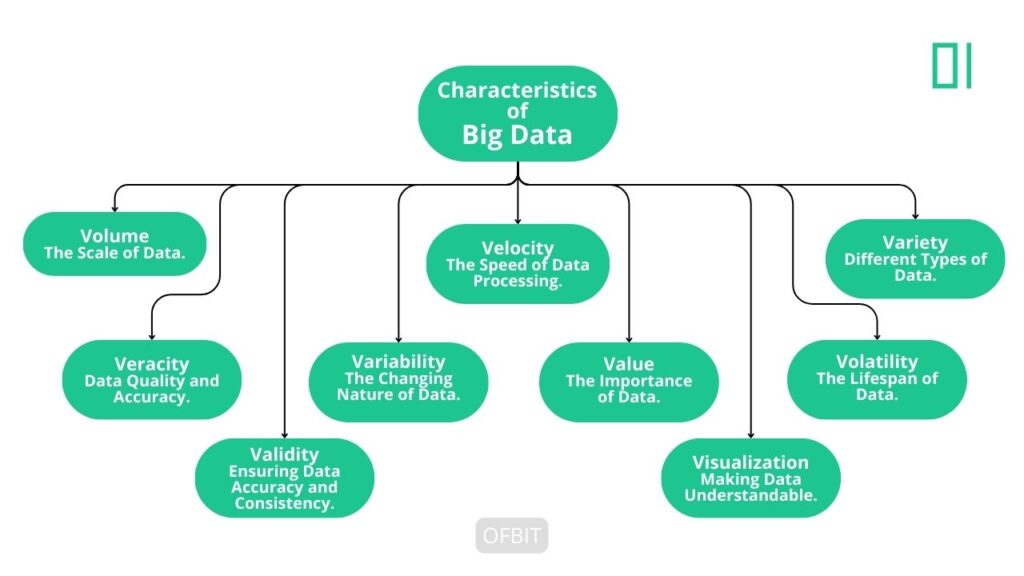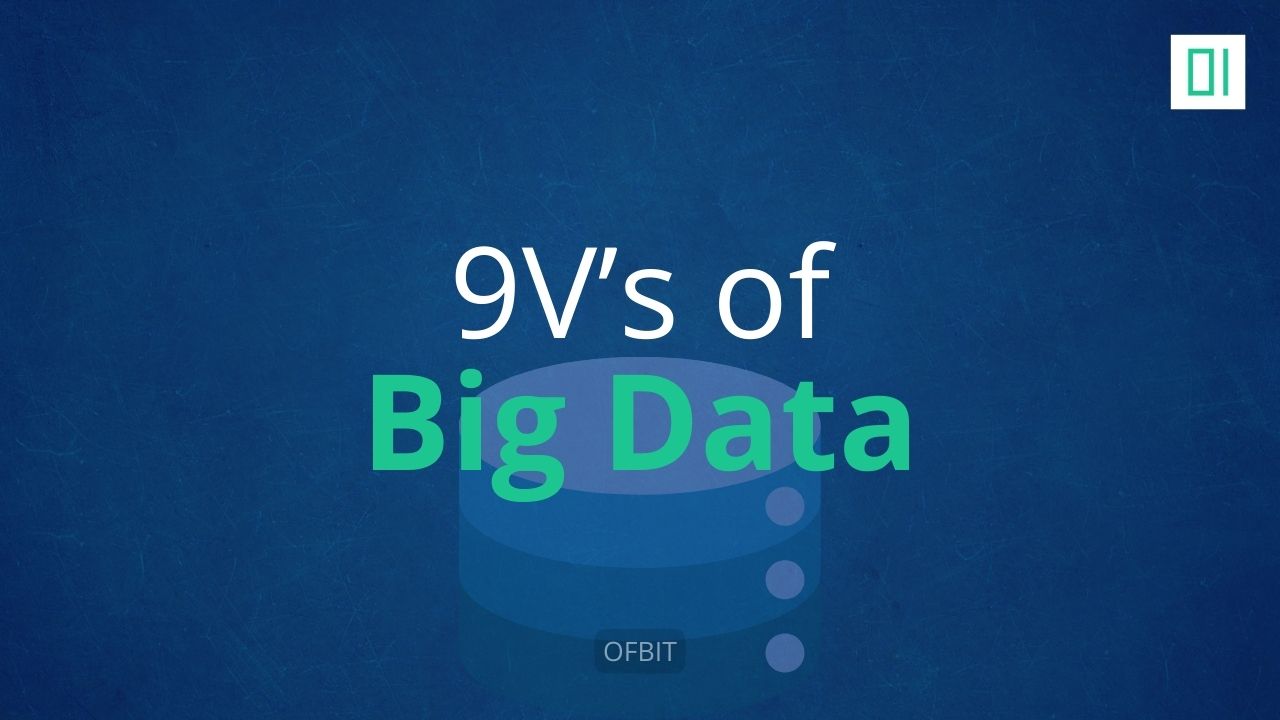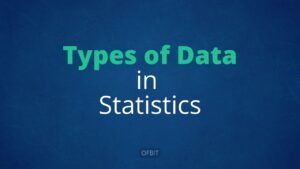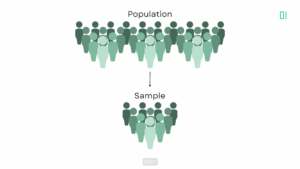Big Data has revolutionized the digital landscape, enabling businesses and organizations to make data-driven decisions. But what makes Big Data so powerful? The characteristics of Big Data define its essence and usability. These characteristics are commonly categorized into the V’s of Big Data, each representing a unique attribute that helps in processing, managing, and analyzing massive datasets.
It is important to have a thorough understanding of the Characteristics of Big Data in order to get a handle on how the concept of big data works and how it can be used.
Characteristics of Big Data
While learning What is Big Data, we mentioned Big Data characterized by mainly 3V’s. These 3V’s of Big Data are: Volume, Velocity and Variety. But nowadays Big Data characteristics are defined by 5V’s, 6V’s and 7V’s. However, there are total 9V’s of Big Data which makes it so powerful.

Let’s explore these V’s of Big Data in detail.
3v’s of Big Data
The characteristics of Big Data, often known as the “3 V’s of Big Data,” were first defined by Gartner in 2001.
Volume: The Scale of Data
One of the primary characteristics of Big Data is its high Volume. The amount of data generated every single minute through social media, IoT devices, business transactions, digital interaction etc. is referred to as a Volume. It is measured in units like Terabytes (TB), Petabytes (PB), Exabytes (EB), Zettabytes (ZB), and Yottabytes (YB). Industry trends show that data volume has been growing exponentially.
Velocity: The Speed of Data Processing
The speed at which data is generated and needs to be processed is known as its Velocity. High velocity is crucial for efficiently handling large volumes of data. The ability to analyze data quickly allows businesses to make real-time decisions, enhancing operational efficiency.
Variety: Different Types of Data
Variety in Big Data means that data comes in many different forms. Big Data is not limited to structured data like databases; it also includes unstructured and semi-structured data such as images, videos, emails, and social media posts. Managing this diverse data format is crucial for extracting meaningful insights.
Along with the original 3Vs of Big Data, three more are often highlighted for maximizing the potential of Big Data: veracity, variability, and value.
Veracity: Data Quality and Accuracy
Not all data is reliable. One of the key characteristics of Big Data is Veracity, which focuses on the accuracy and trustworthiness of data. The higher the veracity of the data, the more trustworthy it is.
Large datasets can be difficult to manage and understand, while small datasets may not give you all the information you need for a clear picture. Poor data quality can lead to incorrect analytics and business decisions, making data validation a critical aspect.
Variability: The Changing Nature of Data
The field of Big Data is dynamic and constantly evolving. Sometimes, the information you gather from one source may differ from what you find later. Imagine you check the weather app. Yesterday it said sunny, but today it says rainy. This inconsistency is known as data variability, which affects the homogeneity of your data.
Value: The Importance of Data
Data alone holds no significance unless it provides Value. The benefits that are gained from utilizing the data are referred to as Value. Extracting useful insights from Big Data helps businesses improve decision-making, customer experience, and overall productivity. Thus, in Big Data, Value is another important characteristic.
Additional V’s of Big Data
Apart from the 6V’s of Big Data that we learned in the last section, here are additional 3Vs of Big Data which make Big Data so powerful.
Volatility: The Lifespan of Data
Volatility refers to how long data remains valuable before it becomes outdated. Not all data retains its relevance over time. Certain types of data, such as public sentiment, opinions only relevant for some time and become outdated fast.
Validity: Ensuring Data Accuracy and Consistency
Validity focuses on whether data is correct, consistent, and applicable for analysis. Even if data is vast and rapidly generated, it must be valid to provide reliable insights.
Visualization: Making Data Understandable
Big Data is only useful if it can be interpreted effectively. Visualization involves representing data through charts, graphs, and dashboards, making complex information more accessible and actionable for decision-makers.
Summary | Characteristics of Big Data – V’s of Big Data
In this tutorial, you have learned about the characteristics of Big Data, not only 3Vs Big Data, or 5Vs Big Data or 6Vs Big Data, we learn about all 9Vs of Big Data. Moreover, with the rise of Data Science, these characteristics help professionals build advanced analytical models, drive innovation, and unlock new opportunities in various industries.
FAQs About Big Data Characteristics
What are the 3V’s of Big Data?
The 3 V’s of Big Data are Volume, Velocity, and Variety. These define the scale, speed, and types of data generated.
What are the 4vs of Big Data?
The 4 V’s of Big Data include Volume, Velocity, Variety, and Veracity, where veracity focuses on the accuracy and trustworthiness of data.
What are the 5vs of Big Data?
The 5 V’s of Big Data consist of Volume, Velocity, Variety, Veracity, and Value, highlighting the importance of deriving meaningful insights from data.
What are the 6V’s of Big Data?
The 6 V’s of Big Data expand on the previous five by adding Variability, which refers to the changing nature of data.
What are the 7V’s of Big Data?
The 7 V’s of Big Data include Volume, Velocity, Variety, Veracity, Value, Variability, and Visualization, emphasizing the importance of data representation.
Stay Connected & Keep Learning!
Did you find our articles and tutorials helpful? Stay updated with more expert tips—Follow us on Facebook and Instagram!
Be Part of a Global Tech Network! Join our Official Facebook Group for live Q&A, discussions, and networking with a global tech community!




